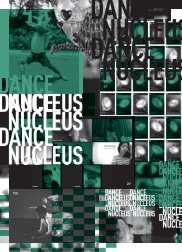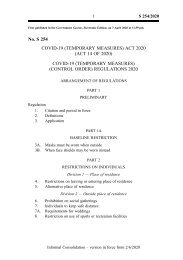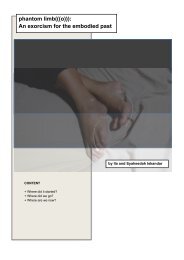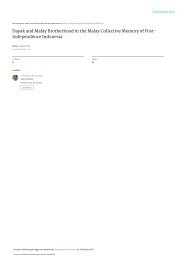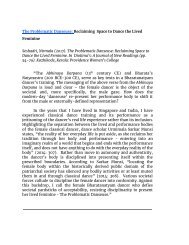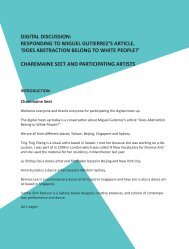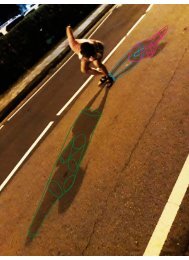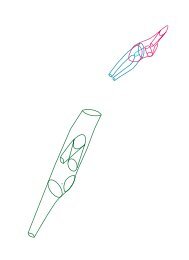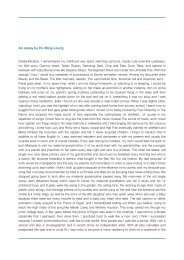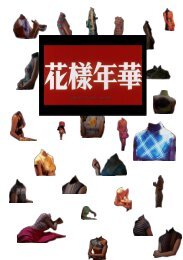FUSE#2
FUSE is a bi-annual publication that documents the projects at Dance Nucleus .
FUSE is a bi-annual publication that documents the projects at Dance Nucleus .
Create successful ePaper yourself
Turn your PDF publications into a flip-book with our unique Google optimized e-Paper software.
Element# 2<br />
BAHASA KOREOGRAFI<br />
Body Archive<br />
Body archive was the main subject in my exploration of the<br />
meaning and identity behind the dance forms of tari piring (saucer<br />
dance originating from the Minangkabau people) and zapin (a<br />
Malay dance form with Arab influences). I linked these two forms<br />
with the movements of silat (a martial arts form). Fundamentally,<br />
the main basis for these two dances is silat. My main objective in<br />
this exploration is to find the ‘blurred’ space between these three<br />
forms and to breathe new life into those movements. The<br />
‘movements’ referred to include movement vocabulary,<br />
articulation of form, idea, space and image as well as the totality<br />
of the performance.<br />
The starting point of my exploration was one of my works called<br />
‘stalemate’ which was a traditional dance piece that was given a<br />
contemporary treatment. In creating this work, I interpreted tari<br />
piring using a more unconventional approach by paying close<br />
attention to its visual aspects. Specifically in terms of the<br />
costumes, props, movement articulation and also lighting design.<br />
But the crux of why I chose to base my dance on tari piring is<br />
because I grew up and was trained in that particular form.<br />
by Fauzi Amiridin<br />
At the same time, I tried to connect tari piring with zapin because they had<br />
structures that could be elaborated and creatively reinterpreted. This is because<br />
the core movements in zapin and tari piring are also the basic movements in silat.<br />
What I am trying to discover are the points and lines which are vague and ‘blurred’.<br />
And how these can create forms that are more relevant and contemporary.<br />
As part of the process of discussion, we began with the topic of<br />
what it meant to be practise-based and also the lineage attached<br />
to a performer/choreographer. These topics were explored during<br />
our sharing sessions. During the process I reflected a lot on the<br />
issue of memory. These memories are related to the process by<br />
which I first become involved in the arts. And then it evolved into<br />
discussions on muscle memory, in which I recalled the various<br />
forms of dance that I have studied. In the process of finding my<br />
identity through my work, I thought about how my search for<br />
movements forms took the form of improvisations, composition<br />
and choreography. Personally, I don’t over-think about what<br />
movements to show when I move, but am guided more by my<br />
imagination and also the memories in my body. What I realised<br />
was that my research process began with memory (the starting<br />
date of my encounter with the dance) and then on to muscle<br />
memories and then narrowed down to the main objective of my<br />
search, which is the exploration of a ‘body archive’.<br />
In our subsequent discussions, various questions were raised,<br />
like how far we were into our respective explorations into the<br />
concepts and ideologies informing our works. What were the<br />
reference materials that we had used for our research? I was<br />
especially drawn to the notion of the performer’s memories. This<br />
is specifically with reference to my own self and how my own<br />
body (as an archive) has recorded, and stored for retrieval, every<br />
dance form that I have learnt. This has made me more aware of<br />
each movement that I produce. These movements are based on<br />
those which I remember but which I choose to reproduce in a<br />
‘blurred’ space, between the space of tradition and the space of<br />
the contemporary. At the same time, I tried to think of my own<br />
identity as a choreographer. What is my role in finding the<br />
meaning and purpose in that ‘blurred’ gap?<br />
49 50




